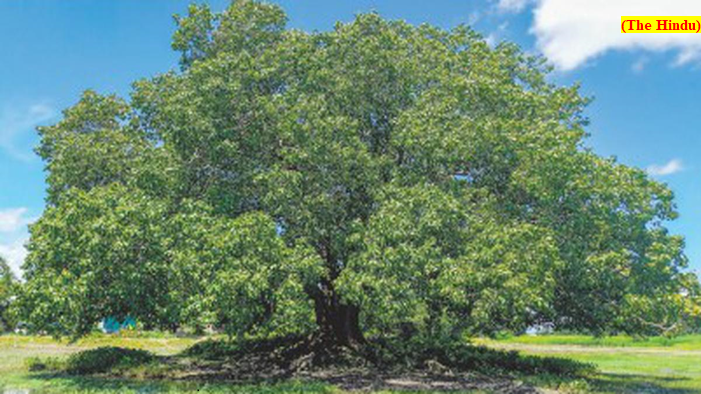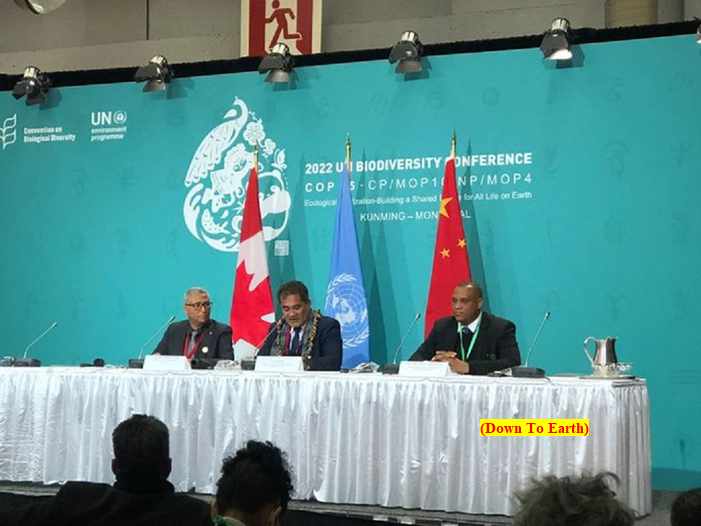Genes responsible for long lifespan of banyan, peepal trees identified (GS Paper 3, Science and Tech)

Why in news?
- Researchers at the Indian Institute of Science Education and Research (IISER) Bhopal have carried out whole genome sequencing of banyan (Ficus benghalensis) and peepal (Ficus religiosa) from leaf tissue samples.
- They also undertook a comprehensive genome-wide phylogenetic analysis with 50 other angiosperm plant species, including four other sequenced Ficus species.
- Genome sizes of these two Ficus species were corrected compared to the previously estimated genome sizes.
Adaptive Evolution:
- The work helped in identifying 17 genes in the case of banyan and 19 genes of peepal with multiple signs of adaptive evolution (MSA) that play a pivotal role in long-time survival of these two Ficus species.
- The genes with multiple signs of adaptive evolution came about in response to population bottleneck faced by both trees around 0.8 million years ago.
- The inclusion of coding genes from other Ficus species helped the researchers identify plausible species-specific genes responsible for the morphological characteristics and evolutionary adaptation in these two plant species.
MSA genes:
- Genes showing multiple signs of adaptive evolution in banyan were mainly associated with root development, leaf formation, metabolism, pollen tube and seed development and other developmental processes.
- The MSA genes of peepal trees were mainly associated with root development, reproduction, metabolism.
- Gene family expansion/contraction analysis undertaken by the researchers revealed that the highly expanded gene families of both the species were involved in disease resistance functions in plants.
- Disease resistance gene families showed gene expansion as well as high gene expression in these species, which can be used as a signature of long-lived plants.
Stress tolerance:
- In the case of banyan tree, 15 of 17 MSA genes were also associated with tolerance against environmental stress; drought, oxidative stress, and pathogens. In peepal trees, 17 out of 19 MSA genes were associated with stress tolerance activities.
- In addition, the researchers identified seven genes involved in two pathways that produce volatile organic compounds in floral scents, which attract wasps for pollination.
Key Findings:
- The adaptive evolution in genes in two cellular mechanisms might explain the well-developed aerial roots that is unique to banyan trees.
- These aerial roots help provide much support for the growth and survival of large trees against environmental challenges particularly strong winds that uproot many other similarly large trees.
- Both plants show genes with signatures of multiple adaptive evolution involved in phytohormone signalling pathways. These pathways function to regulate plant developmental senescence and ageing processes. This could be one more reason why banyan and peepal trees have a long lifespan.
- Both banyan and peepal trees have select plant disease resistance gene families that have been expanded through gene duplication events in the course of evolution which confers greater longevity.
- Also, 88% and 89% of the MSA genes in banyan and peepal trees, respectively, are associated with tolerance against biotic and abiotic stress responses. This, in turn, helps these plants to survive when faced with environmental challenges.
Way Forward:
- To survive in tropical and sub-tropical ecosystems as keystone species, Ficus trees have evolved their developmental and stress tolerance mechanisms. Stress tolerance mechanisms are also responsible for the medicinal properties of these trees.
- Availability of their genome sequences will aid in further studies on this ecologically important genus and other comparative aspects, including medicinal properties between short-lived and long-lived plants.
NASA launches first-ever mission SWOT to observe nearly all water on Earth
(GS Paper 3, Science and Tech)
Why in news?
- NASA has launched the first-ever global satellite mission that will observe nearly all water on Earth's surface, measuring the height of water in the planet's lakes, rivers, reservoirs, and the ocean.
- The Surface Water and Ocean Topography (SWOT) spacecraft atop a SpaceX Falcon 9 rocket was launched from Vandenberg Space Force Base in California.

Details:
- SWOT, the advanced radar satellite is designed to give an unprecedented view of the life-giving fluid covering 70% of the planet, shedding new light on the mechanics and consequences of climate change.
- If all goes as planned, the SUV-sized satellite will produce research data within several months.
- Nearly 20 years in development, the SWOT incorporates advanced microwave radar technology that scientists say will collect height-surface measurements of oceans, lakes, reservoirs and rivers in high-definition detail over 90% of the globe.
Salient features:
- The satellite will measure the height of water in freshwater bodies and the ocean on more than 90 per cent of Earth's surface.
- This information will provide insights into how the ocean influences climate change; how a warming world affects lakes, rivers, and reservoirs; and how communities can better prepare for disasters, such as floods,.
- SWOT will cover the entire Earth's surface between 78 degrees south and 78 degrees north latitude at least once every 21 days, sending back about one terabyte of unprocessed data per day.
- One major thrust of the mission is to explore how oceans absorb atmospheric heat and carbon dioxide in a natural process that moderates global temperatures and climate change.
Better results:
- Scanning the seas from orbit, the SWOT was designed to precisely measure fine differences in surface elevations around smaller currents and eddies, where much the oceans’ drawdown of heat and carbon is believed to occur. The SWOT can do so with 10 times greater resolution than existing technologies.
- The SWOT’s ability to discern smaller surface features will help study the impact of rising ocean levels on coastlines. More precise data along tidal zones would help predict how far storm-surge flooding may penetrate inland.
- Freshwater bodies are another key focus of the SWOT, equipped to observe the entire length of nearly all rivers wider than 330 feet and more than 1 million lakes and reservoirs larger than 15 acres.
Way Forward:
- SWOT measurements will also help researchers, policymakers, and resource managers better assess and plan for things, including floods and droughts.
‘Coalition for Nature’ formed by Small Island Developing States
(GS Paper 3, Environment)
Why in news?
- A number of Small Island Developing States (SIDS) have agreed to form a ‘Coalition for Nature’ for the implementation and adoption of the Global Biodiversity Framework (GBF) at the 15th Conference of Parties (COP15) to the Convention on Biological Diversity.

Details:
- The coalition is being led by Cabo Verde, Samoa and Seychelles.
- The organisers of the event made a call to action for “enhancing means of implementing ambitious objectives for nature in SIDS under the Post-2020 Global Biodiversity Framework (GBF).”
Goal:
- The goal of the coalition is to advocate for agreed common SIDS priorities and needs such as greater means of implementing biodiversity objectives in these places by putting up a unified front.
Significance of SIDS:
- SIDS host 19 per cent of the world’s coral reefs and their geographic isolation safeguards an array of endemic plants and animals found nowhere else on earth.
- The island states are responsible for an ocean area 28 times the size of their land mass.
Members:
- Belize, Cabo Verde, Comoros, Dominican Republic, Guinea Bissau, Kiribati, Samoa, Saint Lucia, Sao Tome and Principe, Seychelles, Solomon Islands, Tuvalu and Vanuatu are the current members of the coalition with Germany, France, Italy, Luxembourg, Monaco, Netherlands, Portugal, Spain and United Kingdom as Friends of the SIDS Coalition.
SIDS Coalition:
- The purpose of the SIDS Coalition is to underline how SIDS are home to a large portion of the world’s biodiversity and show that they have been using nature-based solutions and leading the world by example.
- It will also highlight how enhancing the means of implementation of SIDS will be strategic to save the planet.
- The SIDS Coalition called for “a capacity development plan for SIDS to support the implementation of the global biodiversity framework (GBF)”. This will be a strategic vehicle to catalyse technical and financial support for SIDS’ national implementation of GBF.
Finance solutions:
It called for increasing SIDS’ access to concessional finance and finance solutions for biodiversity conservation such as:
- Supporting blended and innovative finance mechanisms, solutions and associated policy frameworks to incentivize and de-risk investment
- Supporting SIDS’ technical cooperation, technological transfer and data management capacities by enhancing national capacities for creating science-policy interfaces. These would have a focus on national environmental accounting systems, valuation tools for ecosystem services and usability / accessibility of existing data banks
- Accelerating biodiversity mainstreaming across sectors and synergies across the three Rio Conventions.
Support:
- The SIDS Coalition will be supported by the Friends of the Coalition in the form of ‘voice of support’, implementation of the SIDS Call for Action or by contributing to the lean virtual secretariat support for the sustained operation of the Coalition.
- The UK committed doubling climate finance through a $500 million Blue Planet Fund to help SIDS develop blue economies.




